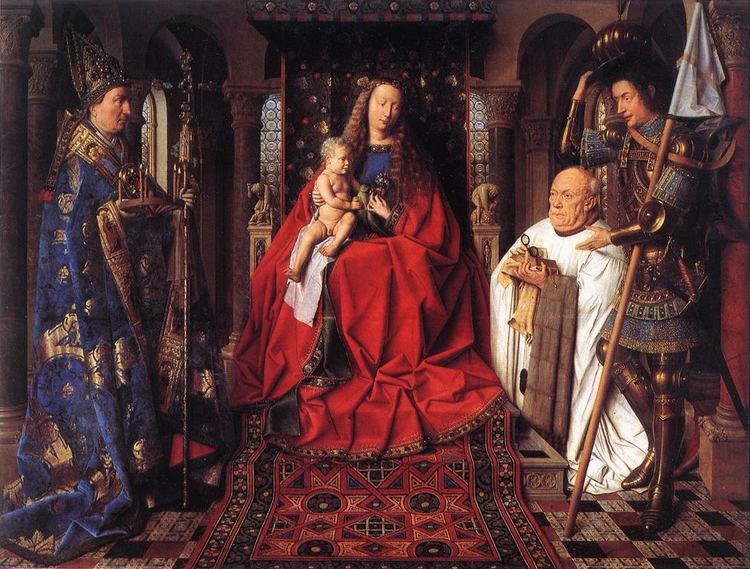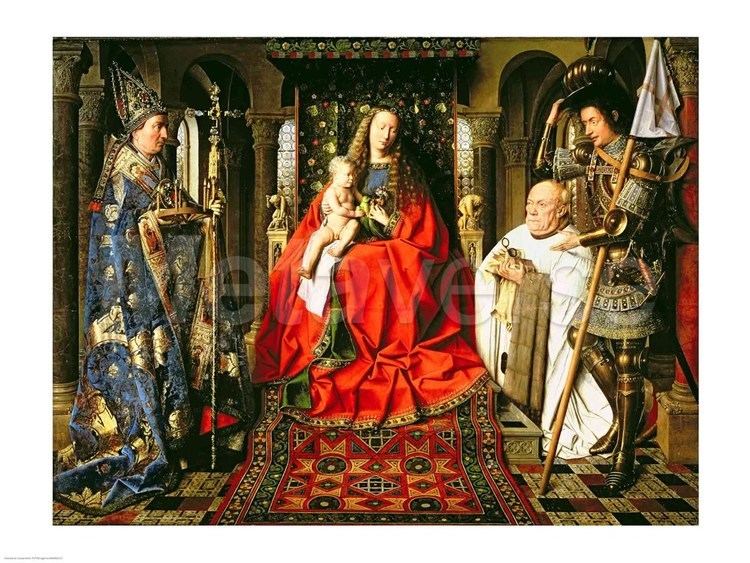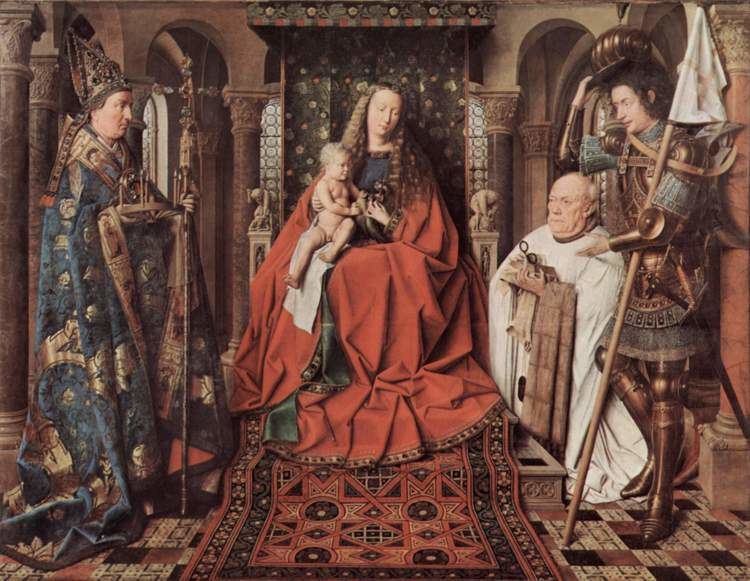Period Northern Renaissance | Created 1436 Genres Portrait, Christian art | |
 | ||
Similar Jan van Eyck artwork, Northern Renaissance artwork, Christian art | ||
The Virgin and Child with Canon van der Paele is a large oil-on-oak panel painting by the Early Netherlandish artist Jan van Eyck. It was commissioned as an epitaph for Joris van der Paele, a wealthy clergyman from Bruges. It shows the Virgin Mary and the child Jesus seated on an elevated throne decorated with carved representations of Adam and Eve, prefigurations of the Crucifixion and Resurrection of Jesus, and scenes from the Old Testament. Mary is positioned at the centre of a tight semicircular and sacred space, seemingly modelled on and representing a church interior. Saint Donatian of Reims, patron saint of Bruges' collegiate church, stands to the left, with Saint George (van der Paele's name saint) in medieval knight's armour, on the right. Both are identified in the Latin inscriptions on the lower border of the imitation bronze frame. George is shown lifting his helmet in respect and presenting the elderly Canon van der Paele to Mary. Van der Paele is dressed in a white surplice and is shown piously reading from a book of hours.
Contents

It is one of the earliest known sacra conversazione paintings of the Northern Renaissance. The work has an overall sculptural look; the throne, windows, arches and hanging canvases borrow from the conventions of Romanesque architecture. It is in its original oak frame, and contains a number of Latin inscriptions; Donatian is described as having "Enjoy[ed] the Glory of God", while George has "Triumphed over Death". The upper border of the frame contains words from the Book of Wisdom, comparing Mary to an "unspotted mirror".

It was commissioned in the autumn of 1434 to celebrate Van der Paele's dedication to his church, St. Donatian's Cathedral in Bruges, and as his epitaph. The Virgin and Child contains one of the finest extant examples of Oriental carpets in Renaissance painting and seems influenced by manuscript illumination. The painting is characterised by its innovative use of illusionism and complex spatial composition, and incorporates rich and detailed symbolism and allegory. It is widely considered one of van Eyck's most fully realised and ambitious works and has been described as a "masterpiece of masterpieces".

Commission

Joris van der Paele was born in Bruges around 1370, and spent his early career as a papal scribe in Rome before returning to his native city in 1425 as a wealthy man. He was appointed to a canonry of the St Donatian's collegiate church, a position which afforded him income from the various parishes under his remit, and allowed him to commission the best painter in the region.
An illness around 1431 left van der Paele unable to fulfill the role and to question his mortality and his position as canon. In response he endowed a chaplainy to the church and commissioned this work from van Eyck. His bequest allowed him a requiem mass, a daily mass and three votive masses a week. A second chaplaincy in 1443 centered on prayers for his family, and guaranteed that after his death, the requiem mass would end with readings of the Miserere mei and de Profundis. An inscription on the lower imitation frame refers to the donation, "Joris van der Paele, canon of this church, had this work made by painter Jan van Eyck. And he founded two chaplaincies here in the choir of the Lord. 1434. He only completed it in 1436, however." Art historian Barbara Lane speculates that van der Paele may have sought divine protection through prayers and the depiction of intercessors in the painting as relief from his long illness.
In the early 15th century Mary grew in importance as an intercessor between the divine and members of the Christian faith. The concept of purgatory as an intermediary state that each human soul had to pass through before admission to heaven was at its height. There was a trend towards the sponsorship of requiem masses, often as part of the terms of a will, a practice that van der Paele, in his official capacity, is known to have actively sponsored. With this income he endowed the churches with embroidered cloths and metal accessories such as chalices, plates and candlesticks.
During his lifetime he may have kept it in his private chambers or on an altar in the church as a retable, available for personal devotion. The panel was donated to the church either in 1436, or on van der Paele's death in 1443. It remained there until the church was demolished in 1779. Most likely the work was first hung in the church nave as an accompaniment to an altar for Saints Peter and Paul, and used for memorial masses for van der Paele and his family. It was installed at the main altar after the Iconoclasm of 1566.
Panel
The painting shows Joris van der Paele deep in meditation and prayer, removing his glasses while holding a book of prayers – both symbols of wealth and education – as he pauses to reflect on a passage he has just read. At that moment the Virgin, Child and two saints appear before him as embodiments of his prayer. The saints and donor seem to have entered through the arcade of the ambulatory.
It is the largest van Eyck painted, except the center panel of the Ghent Altarpiece, and the only in a horizontal format. The Sacra conversazione is set in a rounded church with side ambulatories, in what Elisabeth Dhanens describes as a balanced, symmetrical composition. It is a departure from conventional and contemporary central and northern European epitaphs. He abandons the strict symmetry and clear theological basis of the typical Italian sacra conversazione to create a work that stands up to a variety of interpretations and contains a number of layers of reality, the latter especially achieved through the carved figures on the throne and on the capitals behind. The carvings include old and new testament characters, and allude to either the Crucifixion – to the left of the Virgin and Child – or the resurrection – to the right of the two figures. The scene seems to be illuminated from invisible windows, with light spilling in from the left foreground and from above. The leaded windows behind the Virgin's throne provide soft illumination. The figures are in a church, surrounded by an arcade of semi-circular arches, which suggests if might be a choir. Dhanens explains that van Eyck never painted churches that exist in reality, instead using an amalgam for a setting. The church might resemble St Donatian's, which has since been demolished; it does seem to share similarities with Church of the Holy Sepulchre in Jerusalem, according to Borchert, who writes that in this painting van Eyck shows the "formal language of romanesque architecture".
Figures
The Virgin sits on an elevated throne situated below a minutely detailed and extravagantly decorated brocade baldachin. The steps leading up to it are covered with an oriental carpet. The overhanging tapestry contains white rose patterns, symbolizing the Virgin's purity. The throne contains a number of carved figures including representations of Adam and Eve on the upper arms, and on the legs, a number of prefiguring events from the Life of Christ and old testament scenes, including the meeting of Abraham and Melchizedek, and the Sacrifice of Isaac. The Child has curly blond hair and sits animated and upright at the side of her lap, perched on a white cloth. He is shown frontally, with his head in three quarters view. He reaches for the parrot on her lap.
Canon van der Paele kneels to the right of the Virgin and Child and is depicted as a somewhat distracted and absent-minded figure. This is intentional, an indication that he is, in the words of art historian Bret Rothstein, "disconnected from the perceptible world", and fully absorbed in the spiritual realm. This notion is reinforced by his glasses which, although they imply education, wealth and learning, also allude to fallibility of the human, earthly senses. Van Eyck realistically captured the effects of his illness. The canon's weak vision, his enlarged temporal arteries, and swollen fingers are rendered accurately.
St Donatian is positioned to the left of the Virgin, the more significant position in heraldic terms, and reflective of his status of patron saint of the Bruges collegiate. He appears to stand in front a set of window that are just outside of the pictorial space. In his left hand he holds a jewelled processional cross, in his right a wheel holding five lit tapered candles. The wheel refers to an incident when he nearly drowned after being thrown into the Tiber, but was saved after Pope Dionysius threw him a carriage wheel he was able to use as a float. He wears a cope and mitre resembling vestments known from a contemporary inventories of the church. The vestments are of rich blue brocade, embroidered with images of the saints.
St George stands wears a helmet and lavishly decorated armour. He raises his helmet and left hand to introduce the donor to the Virgin. His seems relaxed, and nonchalant; according to Pächt, he "almost seems to step forward as he doffs his helmet and stretches out his left hand to present to present his kneeling protege to the Madonna and Child: and unusually spontaneous gesture for Jan." George has a double significance in the panel; he is the donor's name saint, while St. Donatian's Cathedral held a relic of him, thought to be one of his arm bones – the Church was built c. 950 to house a relic of St. Donatian. The armour he wears is similar to St Michael's in van Eyck's Dresden Triptych, his metal shield resembles those in the Knights of Christ panel of the Ghent altarpiece.
Inscriptions
The frame is inscribed with van Eyck's signature and lettering identifying each figure. The words to the right of St. George read "NATUS CAPADOCIA. X[PIST]O MILITAVIT. MVNDI FVG[I]E[N]S OTIA. CESU TRIVMPHAVIT. HIC DRACONEM STRAVIT" (Born in Cappadocia, he was soldier of Christ. Fleeing the idleness / pleasures of the world, he triumphed over death and vanquished the dragon. The letters ADONAI are inscribed on George's breastplate.
Mary's robe is embroidered with Latin text, taken from the Wisdom of Solomon 7:29: Est enim haec speciosior sole et super omnem stellarum dispositionem. Luci conparata invenitur prior ("For she is more beautiful than the sun, and excels every constellation of the stars. Compared with the light she is found to be superior"). Van Eyck used a similar device in his later Berlin Madonna in the Church.
The Inscription beside St. Donatian reads "SOLO P[AR]TV NON[VS] FR[ATRV]M. MERS[VS] REDIT[VR]. RENAT[VS] ARCH[IEPISC]O[PVS] PR[I]M[VS]. REMIS CONSTITVITVR. QVI NV[N]C DEO FRVITVR." (He was the youngest of nine brothers; thrown into the water, he returned to life and became the first archbishop of Reims. He enjoys now the glory of God).
Iconography
Van Eyck incorporated a wide variety of iconographic elements, conveying what he saw as a co-existence of the spiritual and material worlds. The iconography was embedded in the work unobtrusively; typically the references comprised small but key background details. The embedded symbols were meant to meld into the scenes and "was a deliberate strategy to create an experience of spiritual revelation." Virgin and Child is rich with iconography placed symmetrically throughout its two halves – the left references Christ's death, the right his resurrection. According to Borchert, van Eyck was meticulous in "assigning them in formal terms to St Donatian on the left and St George on the right". The painting displays van Eyck's habit of presenting the viewer "with a transfigured view of visible reality”, according to Craig Harbison, by placing small details unobtrusively which "illustrated not earthly existence but what he considered supernatural truth". They would have been easy to discern for a medieval viewer, whereas modern audiences are often confused.
The parrot and plant on Mary's lap are such symbols. According to Ward it is odd, although not "spatially ambiguous it must ultimately be recognized as either curiously incoherent or deliberately designed to enact a complex symbolic message." Mary delicately holds the stem that appears to grow from the parrot's feathers, culminating in a bouquet of red, white and blue four-petalled flowers. A parrot was sometimes used as an emblem for the Virgin, but combined with the plant makes it an incongruous image, according to Ward. He explains that the parrot and plant give emphasis to the floral background, symbolise the Garden of Eden, accented by the figures of Adam of Eve. The flowers’ colors represent purity, love and humility; its petals are a symbol of the cross and Christ's sacrifice. The narrative of original sin, the expulsion, and redemption is thus captured in a single realistic device.
Style and format
Compositionally, the panel shares the same pyramid structure as his earlier Lucca Madonna, but in this work he attempts to solve the problem of showing earthly figures with the heavenly, reserving a sense of the divine for the latter. Pächt explains that the supremacy of the divine is ""maintained thorughout by the use of the elevated throne or other devices to assure a dominant position." Unlike Robert Campin, who typically placed the Virgin in a domestic setting, van Eyck "set the scene in God’s House, thus ensuring that it retained all the solemnity of sacred space, as manifested in the terrestrial enclaves of the Divine." Although the Madonna's throne is in the mid-ground, her head is at the same level of the standing figures in the foreground, who are closer in perspective. The apse in which she sits adds to the illusion of depth and almost appears as an expanded throne niche, with the top of the canopy its upper edge, adding to the sense that the space is self-contained. A similar approach is evident in the later Dresden Triptych, but that work shows a better handling of spatial depth where Mary's throne is moved back, the donors and saints are moved to wing panels, resulting in an illusion that smaller figures are set in a soaring and exalted space. The figures in Canon van der Paele have less space, are somewhat cramped and appear more massive.
As with his c. 1435 Madonna of Chancellor Rolin, the panel creates an intimate setting between the donor and Virgin. This is most obvious in the donor's physical proximity to Virgin which, according to art historian Jeffrey Chipps Smith, "mentally and pictorially [breaches] the barriers between heaven and earth" and implies the "patrons are visually immortalized as meriting the Virgin and Child's personal attention." The intimacy is further enhanced though small details such as the overlap between the donor and Saint George, who casts a shadow on van der Paele and seems to have accidentally have stepped on his surplice as he leans forward to introduce the canon to the Virgin. However, in keeping with the conventions of Early Netherlandish art, van der Paele does not look directly at any of the heavenly figures, an observation of element of social and spiritual decorum.
The figures, the minutely detailed clothes and the architecture of the room and windows are depicted with a high degree of realism. Yet the setting is carefully composed and arranged to flatter the donor. The painting's pictorial space imitates that of a church, with Mary occupying the area where the altarpiece would usually be positioned. The child's position is arranged in a way so as to represent both the host and Eucharist, a common allusion in Early Netherlandish art again reflecting that the panel was likely intended as an attendant to celebrations of the mass.
Van Eyck's mastery at handling oil can be seen in the differing breaths of brush strokes used to create the high degree of realism and minute details. The precise detail is especially noticeable in the rendering of threads of St Donatian's golden and blue embroidered cope and mitre, in the weave of the Oriental carpet and in the stubble and veins visible on van der Paele's aging head. The Virgin and child can be seen in the reflection of Saint George's helmet, while van Eyck alludes to his artistry by including his reflection on the knight's shield. The artist depicts himself standing at his easel, in a red turban similar to that seen in the 1433 possible self-portrait Portrait of a Man, today in the National Gallery, London.
Provenance and attribution
The painting was acquired, with many other Netherlandish and Flemish works, by the Musée du Louvre around 1794 during plundering of the estates of aristocrats during the French revolutionary army's occupation of Southern Netherlands. Other works acquired in this way include the center panels of van Eyck's Ghent Altarpiece, Hans Memling's Moreel Triptych and Gerard David's Judgement of Cambyses. Many, including the van der Paele panel, were returned to Bruges in 1816. The return of this panel became entangled in a dispute over control and ownership between the local French and national Dutch speaking officials of Bruges.
The panel was attributed to van Eyck in 1847 by the German art historian Gustav Friedrich Waagen. Netherlandish art had been unfashionable for centuries, and while it was in the mid-19th century going through a process of rediscovery, there was scant historical record available to link painters to the works. Waagen based his assessment of the inscriptions on the frame, the "explicitly realistic" style he had come to associate with van Eyck, as well as the evident skill in blending hues. However, Waagen was not especially impressed by the panel, he described it as "difficult to enjoy". Like other critics of his era was more inclined towards the understated and 'chaste' style of Memling. He wrote that he found the Virgin "of a rare ugliness", while Saint George appeared to him to be a "by no means saintly character".
